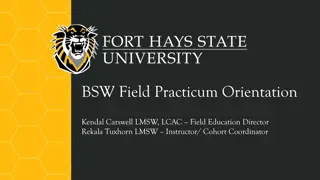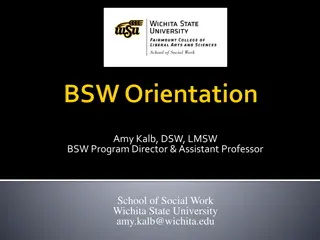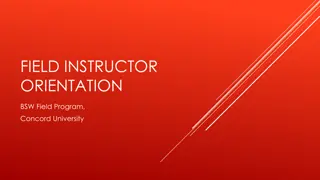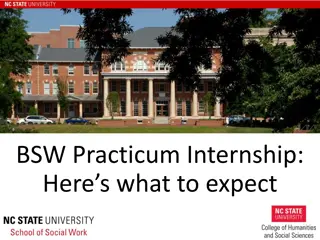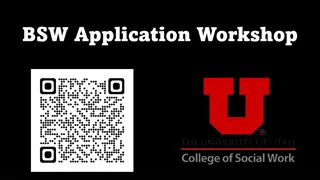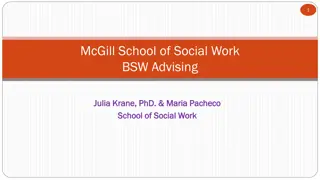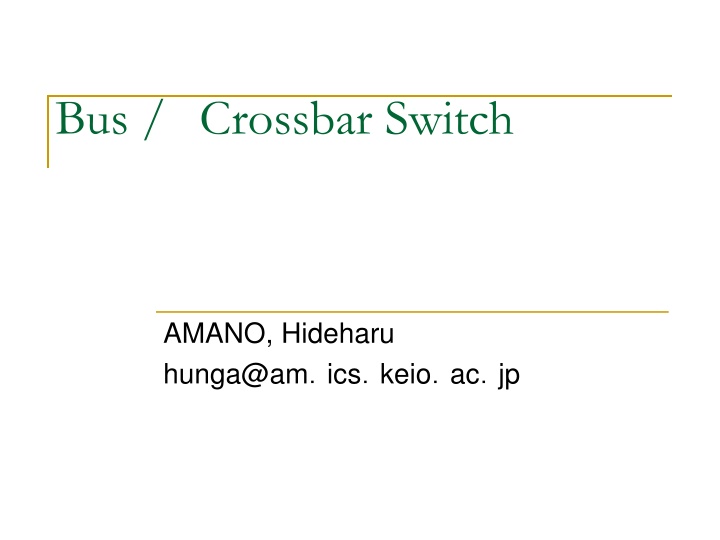
Computer System Architecture and Bus Structures
Explore the intricate details of computer system architecture, including processor hierarchy, memory management, cache structures, bus implementations, and the difference between system and I/O buses. Learn about synchronous versus asynchronous bus communication and the multicore processor design. Discover the critical requirements for high-performance systems and grasp the significance of cache sharing and its impact on system congestion.
Download Presentation

Please find below an Image/Link to download the presentation.
The content on the website is provided AS IS for your information and personal use only. It may not be sold, licensed, or shared on other websites without obtaining consent from the author. If you encounter any issues during the download, it is possible that the publisher has removed the file from their server.
You are allowed to download the files provided on this website for personal or commercial use, subject to the condition that they are used lawfully. All files are the property of their respective owners.
The content on the website is provided AS IS for your information and personal use only. It may not be sold, licensed, or shared on other websites without obtaining consent from the author.
E N D
Presentation Transcript
Bus / Crossbar Switch AMANO, Hideharu hunga@am ics keio ac jp
CPU Transparent from Software Memory Hierarchy Locality is used. On-Chip cache 64KB 1-2clock L1 Cache Small high speed 256KB 3-10clock L2 Cache 2M 4MB 10-20clock L3 Cache SRAM Large low speed Main memory DRAM 4 16GB 50-100clock Managed by Operating System Secondary Memory -msec TB
Uni-processor structure CPU L1 L2 L3 Memory Controller HUB North Bridge Graphics DRAM I/O Controller HUB USB South Bridge PCI/PCIexpress Ether Legacy I/O
Sharing cache introduces congestion PE PE PE PE L1 L2 L3 Memory Controller HUB North Bridge Graphics DRAM I/O Controller HUB USB South Bridge PCI/PCIexpress Ether Legacy I/O
The typical multicore structure PE PE PE PE L1 L1 L1 L1 Snoop Cache L2 Bus L3 Memory Controller HUB Crossbar North Bridge Graphics DRAM I/O Controller HUB USB South Bridge PCI/PCIexpress Ether Legacy I/O
Implementation of buses Passive Bus Board level implementation Active Bus: Chip level implementation Multiplexer A single module sends data to all other modules
Requirements High Performance Bandwidth Throughput Latency Flexibility Universality) The number of modules Clock frequency Electrical characteristics Dedicated Bus Standard Bus
System bus vs. I/O bus System Bus (Dedicated) I/O Bus (Standard)
Synchronous vs. Asynchronous Synchronous bus Data is sent synchronized with a clock Easy to handshake, block (continuous) data transfer Module numbers/types are limited PCI Mbus PCIx PCI express, On chip buses Performance centric Asynchronous bus Data is sent without a system clock Variable modules can be connected VME Futurebus+ Recently, asynchronous buses are not commonly used
Terms around bus Transaction: A continuous data transfer of address and data Arbitration An operation for taking a right to control the bus Bus Master: a module which had a right of controlling the bus through the arbitration Bus Slave modules except the bus master
A sequence of data transfer with the bus Get the mastership with the arbitration Bus Transaction Address transfer Data transfer (repeated if necessary) End of transaction Release the mastership Arbiter hardware Handshake
Arbiter H Daisy Chain Arbiter Priority Encoder Distributed bus Centralized Distributed Centralized arbiter is used inside the chip
Centralized Arbiter = Priority Encoder Tree From CMOS VLSI Design by Weste and Harris
Daisy Chain X X Request Request Request H H L H L H L H L EI EO EI EO EI EO EI EO EI EO If no request EI EO The request can be issued only if EI is H level When the request is issued, EO becomes L level Right side module has a low priority Left side module has a high priority
Open Drain bus H O F F O F F O F F O F F H H H H If all inputs are H , the bus becomes H . H L O F F O F F O F F O F F O N O N H H L H L H If at least an input becomes L , the bus becomes L . If multiple inputs become L it still remains L , Wired-OR(AND Tie)
Open Drain 0 overtakes 1 Distributed bus arbiter Output its own number Check from the upper line. If the value on the line is not equal to its output number, then stop the output.
Modified methodKeios patent Set cut-points on the bus Output its own number Parallel check is possible
Starvation Problem If the priority of the arbiter is fixed, a weak module cannot use the bus continuously. Central arbiter Round robin priority scheduling Distributed arbiter The next request cannot be issued until all requesting modules satisfy their requests.
Round Robin 111 110 101 100 011 010 001 Priority 000 000 111 110 101 100 011 010 001 001 000 111 110 101 100 011 010 010 001 000 111 110 101 100 011
Practical Starvation Avoidance Assume that 0 is the strongest. 111 110 101 100 011 010 001 Priority 000 Blocked Blocked Blocked Blocked All Blocked modules are released
Overlap between the arbitration and data transfer Arbitration n n+1 n+2 n+3 bus master for n+2-th transaction bus master for n-th transaction bus master for n+1-th transaction Data transfer n-1 n n+1 n+1 So, the arbitration time is not critical in most cases.
glossary-1 Arbiter Arbitration Bus master Bus slave Centralized Distributed Daisy Chain Arbiter Transaction Open drain OFF H ON L OR Starvation Round-robin Arbitration
Handshake for data transfer 4-edge 2-line (Strobe + 1 Acknowledge) 2-edge Only for a single slave 4-edge 3-line (Strobe + 2-Acknowledge) 2-edge For multiple slaves
-line -edge handshake Strobe Address/ Data Acknowledge
-line -edge handshake Strobe Address/ Data Acknowledge Data ttem is transferred with both edges of the strobe
In the case of multiple slaves Strobe Address/ Data Module Acknowledge L because 2 is L Module Acknowledge Acknowledge Bus (Wired-OR)
Quiz 3-line handshake (1 for strove and 2 for acknowledge) is used for multiple slaves. Why 2-line handshake cannot manage multiple slaves?
-line cannot manage multiple slaves Strobe Then, go to next transfer Address/ Data Module Acknowledge is still L Module 2 (SLOW!) Acknowledge Slow module Cannot receive Acknowledge Bus (Wired-OR AND) Negative edge cannot be used for synchronization OK
-line handshake Positive edges of two acknowledge lines are used in turn Strobe Address/ Data OK! Next transfer OK! Acknowledge Acknowledge 3-line 2-edge handshake is also possible
Handshake in the chip slave 1 slave 2 Strobe Master slave n Ack1 slave 1 slave 2 AND Master Ack2 slave n AND Of course, wired-or wire is not used. The concept itself is not changed.
Synchronous bus is suitable for block transfer Clock Strobe Address/ Data Acknowledge The start/end handshake is the same, but block transfer is possible synchronized with a clock
Non-Split Transaction Bus utilization is degraded Module A Data transfer Address Module B Memory reading
Split Transaction Module C Module A Address Address B A C D Module B Module D Split transaction of A B Transaction C D is executed
Advanced I/O Buses PCI bus was widely used, but it could not cope with recent computer system. 32bit/33MHz, 64bit/66MHz New standard I/O bus PCI-X 64bit/133MHz DDR/QDR PCI Express Point-to-point serial data transfer 1 lane:2.5Gbps x2, x4, x8 Now, PCI Express is used instead of PCI bus.
PCI Express Consisting of serial one-to-one bidirectional connection wires called lanes. Each lane supports 2.5Gbps/5Gbps (Physical Speed) Multiple lanes can be used as a link(x4, x8, x16 and x32). The data is transferred in a packet called TLP (Transaction Layer Packet). Interconnection network rather than the bus, but the protocol of traditional PCI bus is supported. lane port port Physical layer Physical layer link
PCIe standards Gen1 Gen2 Gen3 Gen4 Physical speed Gbps Bandwidth (GB/sec) x8 bandwidth (GB/sec) Encoding 2.5 5 8 16 0.25 0.5 1.0 (0.985) 7.9 2.0 (1.969 15.75 2.0 4.0 8b/10b 8b/10b 128b/130b 128b/130b Gen3 1.6 2 Now, Gen5 is under preparation.
An example of bus system using PCI express CPU System bus Memory Root Complex Graphics Memory bus Switch Switch PCI Express End point End point End point PCI Bridge PCI bus
On-chip bus For on-chip implementation, various types of IP (Intellectual Property) must be connected. Standard bus is required. AMBA (Advanced Microcontroller Bus Architecture): a bus for ARM cores. CoreConnect: a bus for PowerPC cores. Wrapper based buses IPs are wrapped in the standard interface. For further performance improvement, NoCs (Network on Chips) are introduced. Introduced in the later part of this lecture
NEC MP211 Camera An example of on-chip bus LCD Cam DTV I/F. Sec. Acc. Rot- ater. USB OTG 3D Acc. Image Acc. LCD I/F DMAC ARM926 PE0 APB Bridge1 SRAM Interface Bus Interface TIM1 ARM926 PE1 TIM2 Scheduler APB Bridge0 Inst. RAM On-chip SRAM (640KB) TIM3 SDRAM Controller ARM926 PE2 PMU WDT Async Bridge0 Mem. card PLL OSC PCM SMU uWIRE SPX-K602 DSP Async Bridge1 IIC UART INTCTIM0GPIO SIO FLASH DDR SDRAM
Summary of Bus Classic bus with passive wires has been changed to active bus with a kind of switches High Speed Bus Synchronous bus with Split Transaction Using active devices It becomes somehow like a packet transfer with switching hub.
glossary 2 Handshake Synchronous Asynchronous Strobe Acknowledge Strobe Edge Split transaction
Crossbar switch Cross point: small switching element The number of cross points: Extension of the buses
Non-blocking property For different destination, conflict free
Head Of Line (HOL) conflict Arbiter is required for each bus The buffer is required X The number of cross point is not dominant.
Input buffer switch Input buffer Crossbar One of conflicting packets is selected. Others are stored Into the input buffer
Output buffer switch Output buffer works with n freq. Crossbar Crossbar must work with No HOL problem. Used in switches in WAN, but for parallel machines it is difficult. n frequency of input/output rate.
Buffers at cross-point The buffer is provided at each cross-point. High performance but the total amount of buffer becomes large.
An example of a modern router WH router with two virtual channels (Introduced later in this lecture) ARBITER X+ X+ FIFO X- X- FIFO Y+ Y+ FIFO Y- Y- FIFO 5x5 XBAR CORE CORE FIFO
Merit/demerit of Crossbars Non-blocking property Simple structure/Control The hardware for cross-points usually do not limit the system (Fallacy of crossbars) Extension is difficult by the pin-limitation of LSIs If pins can be used, a large crossbar can be constructed Earth simulator
SUN T1 L2 Core Cache bank Directory Core L2 Core Cache bank Directory Memory Crossbar Switch Core Core L2 Cache bank Directory Core Core L2 FPU Cache bank Directory Core Single issue six-stage pipeline RISC with 16KB Instruction cache/ 8KB Data cache for L1 Total 3MB, 64byte Interleaved





